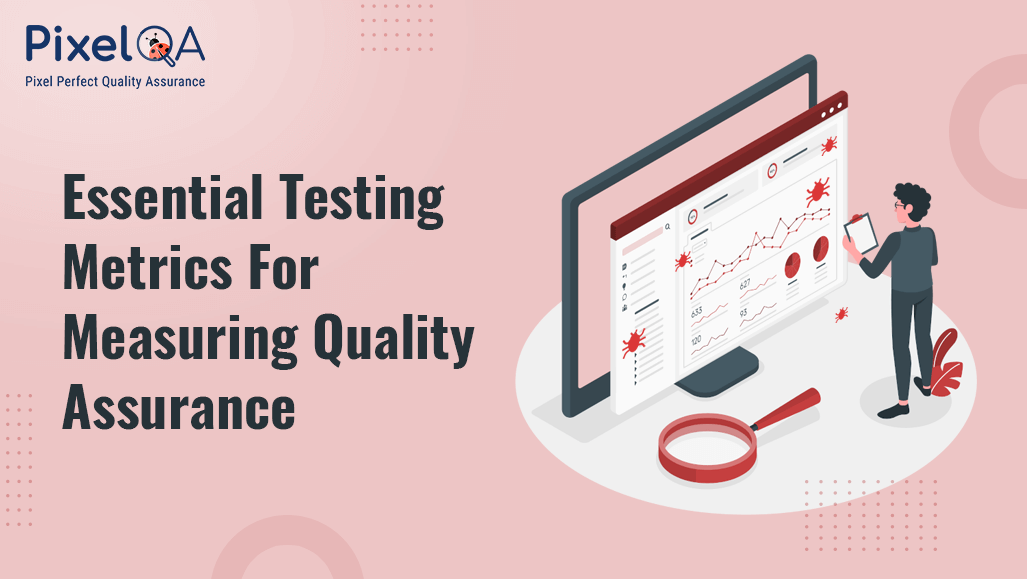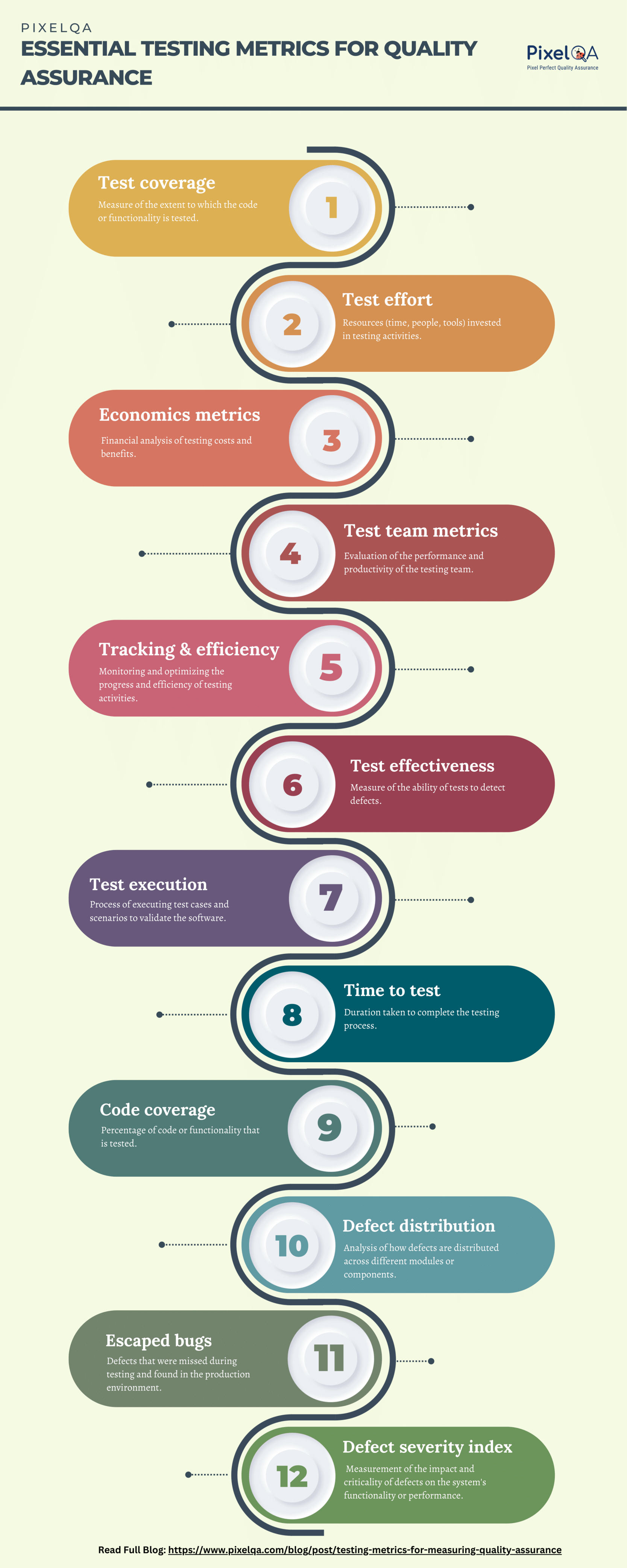
A new software product must be tested before it is released in the market.
In the words of famous management consultant Peter Drucker, “You can't manage what you can't measure,” this statement is enough to implement software quality assurance metrics if your company owns or develops a software or website. These metrics become even more valuable when paired with Automation Testing Services, which help streamline testing efforts and ensure consistent quality measurement throughout the development lifecycle.
Therefore, first, you should know what QA assurance is and what are there types. Then only you can select the best metric as per your requirement. Remember, planning is all about choosing the best alternative out of many.
Table of Content
- Quality assurance: What it is & why it is important
- Why measure quality assurance?
- Types of testing metrics
- Tips for deciding on QA metrics
- Conclusion
Quality assurance: What it is & why it is important
QA stands for quality assurance, which is the process of ensuring the highest possible standard a company offers in its services or merchandise.
QA doesn’t aim to find every bug since it’s impossible in the normal course of software development. Instead, a product's quality assurance aims to give you confidence that it meets a high standard. What’s sufficient?
Why measure quality assurance?
QA metrics can provide various insights into a company's testing procedures. Using them, managers can estimate test efficiency and effectiveness of the test design, execution, team members, and budget allocation by answering these questions:
- Are all parts of the software tested?
- Is it possible to run in predetermined time periods, and can more be done simultaneously?
- Is it going to require more test effort?
- Approximately how long will testing take?
- How much does testing cost, and what is the budget?
- What is the severity of the product defects?
- How many flaws has the team found?
- How many errors do the tests miss?
Identifying the right metrics, and applying them correctly, is essential to planning and implementing QA that yields desired outcomes. Precise and targeted metrics allow testers to stay focused and understand where to improve.
If the pipeline does not improve, managers and executives need to reorient it. After all, making investments without knowing whether they are working or not does not make sense from a business standpoint.
Types of testing metrics
There is no single set of metrics for software testing — each business requires its own software testing metrics. The first step in evaluating a test process is to determine what software testing metrics you might need.
Test coverage
The test coverage metric is used in software testing to measure how many tests are executed. This metric ensures that the testing is completed correctly and facilitates code flow and functionality testing.
Consequently, defects can be prevented during the early stages of product development, thus reducing maintenance costs.
Test effort
Two factors are considered when measuring test effort: the number of tests performed and the amount of time spent on each test. By dividing the number of tests performed by the total testing time, you can determine the number of tests per time-period, allowing you to plan future testing accordingly.
Test economics metrics
The amount of money that can be spent on testing projects is limited. Knowing how much you plan to spend and how much you actually spend is therefore crucial.
Test economics metric provides a summary of test outputs based on the number of testers, the tools used in testing, and the infrastructure used. You can determine testing budgets and measure the return on investment by evaluating everything that went into testing.
Test team metrics
Such metrics can be used to determine whether the work allocation for individual test team members is uniform and whether anyone requires clarification about the process or project.
Test tracking and efficiency
A QA team must be efficient in carrying out all testing activities, from plan and execution to reporting and monitoring software, even after the release. Such efficiency is measured by Test tracking efficiency.
Test effectiveness
Testing effectiveness refers to the ratio of the defect count found before releasing a program relative to the total number of defects found before and after the program's release.
Naturally, test effectiveness metrics are concerned with the quality of the test set. In other words, testing effectiveness addresses questions like, “Did the tests perform well?” or “Do our test cases deliver high value?
Test execution
This metric shows how many tests have been executed compared to the total number of test cases. It provides a measure of test coverage in absolute terms and numbers. Using this method, you can calculate the pass or fail rate of a test build.
Time to test
This metric shows the speed with which a team or tester can design and conduct tests without compromising software quality.
Time to fix
The time spent investigating, fixing, or unit testing a defect that has already been addressed counts as bug-fixing time.
Code coverage
In software testing, code coverage refers to lines of code that have been validated as part of the test process, thereby helping to assess how thoroughly a software has been tested. Code coverage metrics can help your team review automated test results so you can focus your efforts where they are needed in the future.
Defect management and resolution
The purpose of defect management is to find and resolve defects. The process starts with detecting and categorizing a defect which is soon resolved by the developer and verified by the tester.
Defect distribution
It is possible to categorize defects based on their type, origin, source, impact, urgency, system area, software platform, test environment, testing team, project type, and so on. This metric effectively understands the distribution of defects and pinpoints the areas that need the most improvement.
Escaped bugs
Quality assurance exists mainly to keep the majority (or, preferably, all) of bugs out of production. As a result, your entire software quality assurance process can easily be judged by the number of escaped bugs.
Escaped defects found
Escaped defect counts the defects found after the release date of your software. The main difference between defect leakage and escaped defects is that the latter is seen by the users and not the test team.
Defect leakage
In QA testing, the defect leakage metric is used to identify how efficient the testing is by checking the number of defects that were overlooked or slipped through the testing process. Basically, this refers to how many bugs appear during user acceptance testing when the app has gone through multiple levels of testing.
Defect category
The majority of quality control experts divide quality defects into three main categories: minor, major, and critical.
Defect severity index
As the name implies, this is the degree to which a defect impacts a process or part of a software application under test.

Tips for deciding on QA metrics
In some cases, metrics can become paradoxical. As soon as you tie certain outcomes to metrics, they cease to be useful measurements and become merely a means to an end. In other words, they can also be dangerous if misused, despite their effectiveness.
Conclusion
Developers use different metrics to create and assess their testing. We recommend that you educate yourself on these metrics if you're looking to enhance your software's quality. QA metrics are particularly important in Agile processes as managers must pay close attention to even the most infinitesimal details.
At PixelQA, a software testing company, we use a variety of metrics to provide you with the latest tools and methods for the best possible output. Interested for QA Consulting? Contact us.

